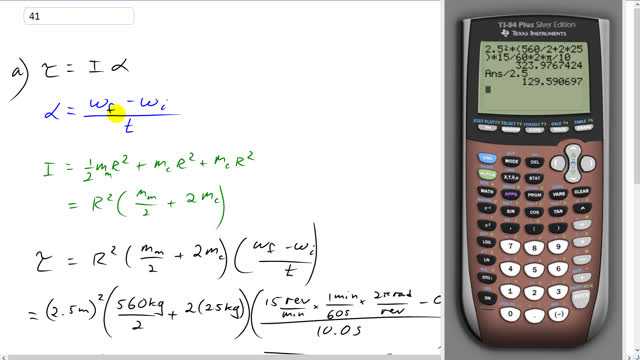
A dad pushes tangentially on a small hand-driven merry-go-round and is able to accelerate it from rest to a frequency of 15 rpm in 10.0 s. Assume the merry-go-round is a uniform disk of radius 2.5 m and has a mass of 560 kg, and two children (each with a mass of 25 kg) sit opposite each other on the edge. Calculate the torque required to produce the acceleration, neglecting frictional torque. What force is required at the edge?

In order to watch this solution you need to have a subscription.
This is Giancoli Answers with Mr. Dychko. Torque is moment of inertia times angular acceleration and we have to figure out each of these factors here. So angular acceleration is the final angular velocity minus the initial divided by time it takes to do this change in angular velocity. And for the moment of inertia, we have three things to consider: we have the merry-go-round itself which is a uniform disk and so its moment of inertia is one-half times mass of the merry-go-round times its radius squared; and then for each of the children, each one can be considered a particle, a point mass, and so its moment of inertia is the mass times its distance from the axis of rotation squared so two turns here, one for each child, and then we can factor out this common factor R squared from all three terms and we are left with mass of the merry-go-round divided by 2 plus two of these child masses collected together so 2 times m c. And substituting that into the formula for torque, we have the total moment of inertia multiplied by the angular acceleration and now we plug in some numbers. So we have 2.5 meters squared times mass of the merry-go-round, 560 kilograms divided by 2, plus 2 times the mass of one child, 25 kilograms, times 15 revolutions per minute which we convert into radians per second by multiplying by 1 minute for every 60 seconds and then times by 2π radians per revolution minus 0 because that's the initial angular velocity divided by 10 seconds and that gives about 320 newton meters. And for the force that the dad has to apply tangentally at the edge of the merry-go-round this is the net torque because we are told to neglect friction so there's only one torque involved and the net torque is gonna be the torque applied by the dad in other words. And so that's gonna be his force times his lever arm and that's the distance to the axis of rotation and they are at right angles so no need to worry about angles here; divide by r on both sides, switch the sides around and we get the force is the torque divided by the lever arm: 323.98 newton meters divided by 2.5 meters which is about 130 newtons.
The actual marry-go-round disk is the total weight - two persons. Which is 560-50 = 510 kg. So, Wouldn't the moment of inertia have to be (2.5)^2(510/2 + 2(25)? I don't understand why you used 560 when calculating the moment of inertia.
Hi theovilous, thanks for the question. What I'm seeing is that the text says
Assume the merry-go-round is a uniform disk of radius 2.5 m and has a mass of 560 kg, and two children (each with a mass of 25 kg) sit opposite each other on the edge.
which gives 560kg as the mass of the merry-go-round disk, not including the children. Perhaps you read that differently and interpreted that the children were included in the 560kg?
Best wishes,
Mr. Dychko
I read the question wrong! thanks for pointing that out! Thank you so much as always!!
My pleasure!